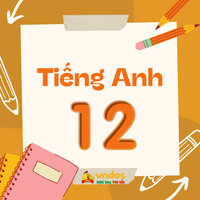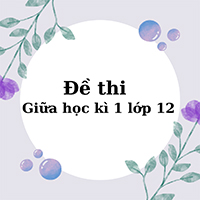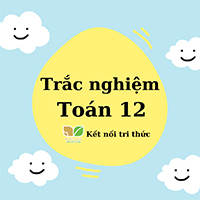Tiếng Anh 12 Global Success Unit 2 Speaking
Tiếng Anh 12 Unit 2 Speaking Global Success
Nằm trong bộ tài liệu Giải tiếng Anh 12 Kết nối tri thức theo từng Unit, Soạn tiếng Anh 12 Unit 2 A Multicultural World giúp các em chuẩn bị bài tập SGK tiếng Anh hiệu quả.
Planning a Cultural Diversity Day
(Lên kế hoạch cho Ngày Đa dạng Văn hóa)
1. Work in pairs. Discuss the differences between Vietnamese culture and some other cultures you know about. Use the ideas in Getting Started and Reading, and the table and examples below to help you.
(Làm việc theo cặp. Thảo luận về sự khác biệt giữa văn hóa Việt Nam và một số nền văn hóa khác mà bạn biết. Sử dụng các ý tưởng trong phần Getting Started, phần Reading, bảng và các ví dụ bên dưới để giúp bạn.)
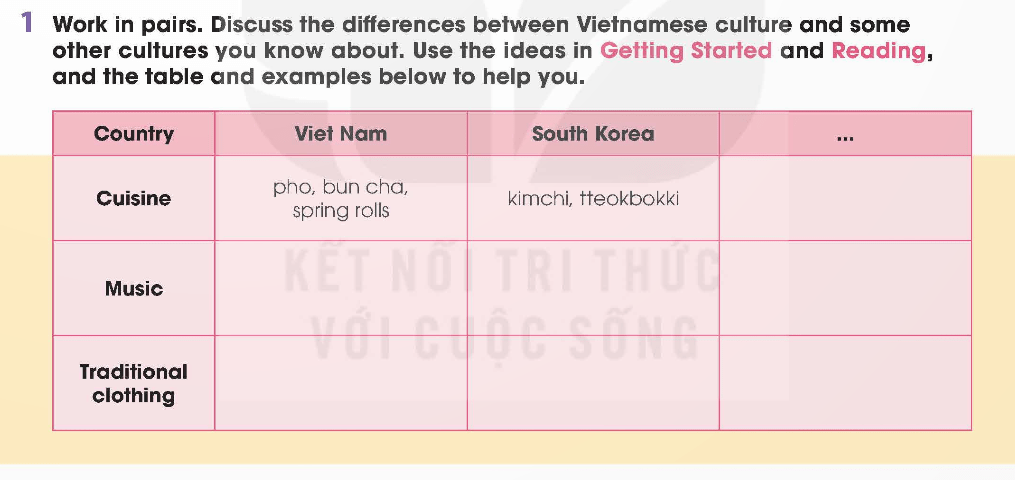
Gợi ý đáp án
|
Country |
Vietnam |
South Korea |
The UK |
|
Cuisine |
pho, bun cha, spring rolls |
kimchi, tteokbokki |
fish and chips, roast beef, curry, haggis |
|
Music |
folk music, chau van, pop music |
K-pop, folk music, classical music |
British pop, classical music, folk music |
|
Traditional clothing |
ao dai/ ao tu than |
hanbok |
the Scottish kilt |
Similarities and differences between Vietnam and South Korea
- Similarities: People in both countries eat rice and noodles, a lot of vegetables, and soups. We both use chopsticks; however, while we use wood or bamboo chopsticks, South Korea eat with metal chopsticks. Street food is a big part of both cultures. We both worshop ancestors, celebrate Lunar New Year, Mid-Autumn Festival, and Buddha’s Birthday. Both nations also have their traditional clothing.
- Differences:
- l Koreans like spicy food while not all Vietnamese eat spicy dishes (except people from some provinces in the Middles or South Vietnam)
- l Music: Traditional Vietnamese music is mainly used for religious activities, in daily life, and in traditional festivals. There are many music forms due to Vietnam’s numerous ethnic groups. These music forms include royal court music, dilettance music, folk music, cheo, quan ho, chau van, etc. Traditional Korean music is typically classified into several types: the “legitimate music” (called jeongak or jeongga) enjoyed by the royalty and aristocracy of Joseon; folk music (court music and dance) performed for the King at celebratory state events; music and dance connected with shamanic and Buddhist and peotic songs beloved of the educated elite.
- Traditional clothing: Korean women wear hanbok while Vietnamese women wear ao tu than or ao dai.
2. Work in groups. Your school is organising a Cultural Diversity Day. Discuss what the event should include. Use the ideas in 1 to create the event programme.
(Làm việc nhóm. Trường học của bạn đang tổ chức Ngày đa dạng văn hóa. Thảo luận về những gì sự kiện nên bao gồm. Sử dụng những ý tưởng ở bài 1 để xây dựng chương trình sự kiện.)
Example:
A: We've decided to organise a Cultural Diversity Day in our school. Let's discuss what activities to include.
B: First, we should set up some food stalls offering traditional dishes from different cultures.
C: That sounds fun! We can call them 'Taste the World'. We can also show visitors how to cook these dishes.
D: I like your idea, but we don't have any cooking experience. We may need to involve professional cooks.
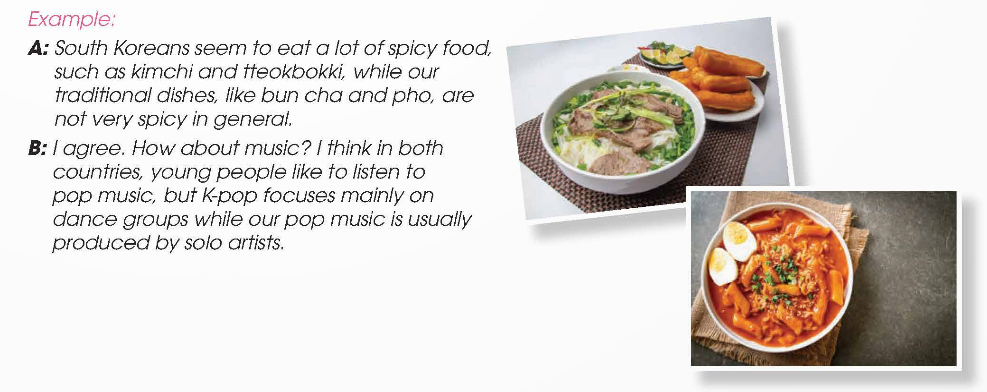
Gợi ý đáp án
A: We've decided to organise a Cultural Diversity Day in our school. Let's discuss what activities to include.
B: How about having cultural performances? We could invite students to showcase traditional dances, music, or even theater from various cultures.
C: That's an excellent idea! We can create a schedule for performances throughout the day. It will be a fantastic way for everyone to experience the richness of different cultures.
D: To involve everyone, let's organize a multicultural fashion show. Students can showcase traditional clothing or even modern outfits inspired by their cultural heritage.
A: Excellent suggestion! We could also incorporate technology by creating QR codes for each culture, linking to short videos or presentations that provide more in-depth insights into their customs, traditions, and celebrations.
3. Report your group's ideas to the whole class. Vote for the best Cultural Diversity Day programme.
(Báo cáo ý tưởng của nhóm bạn cho cả lớp. Bình chọn cho chương trình Ngày Đa dạng văn hóa tốt nhất.)
Gợi ý đáp án
Hi, everyone! We've decided to organise a Cultural Diversity Day in our school, so we have discussed what activities to include, and the following ones are our suggestions. For cultural performances, we could invite students to showcase traditional dances, music, or even theater from various cultures. We can create a schedule for performances throughout the day. It will be a fantastic way for everyone to experience the richness of different cultures. To involve everyone, we will organize a multicultural fashion show. Students can showcase traditional clothing or even modern outfits inspired by their cultural heritage. Finally, we could also incorporate technology by creating QR codes for each culture, linking to short videos or presentations that provide more in-depth insights into their customs, traditions, and celebrations. We hope you will vote Cultural Diversity Day programme for the best. Thank you very much for listening.
Hướng dẫn dịch
Xin chào mọi người! Chúng tôi đã quyết định tổ chức Ngày hội Đa dạng Văn hóa tại trường, vì vậy chúng tôi đã thảo luận về các hoạt động cần thực hiện và sau đây là những gợi ý của chúng tôi. Đối với các buổi biểu diễn văn hóa, chúng tôi có thể mời học sinh trình diễn các điệu múa, âm nhạc hoặc thậm chí là kịch truyền thống từ nhiều nền văn hóa khác nhau. Chúng tôi có thể lập lịch biểu diễn trong suốt cả ngày. Đây sẽ là một cách tuyệt vời để mọi người trải nghiệm sự phong phú của các nền văn hóa khác nhau. Để thu hút mọi người, chúng tôi sẽ tổ chức một buổi trình diễn thời trang đa văn hóa. Học sinh có thể trình diễn trang phục truyền thống hoặc thậm chí là trang phục hiện đại lấy cảm hứng từ di sản văn hóa của họ. Cuối cùng, chúng tôi cũng có thể kết hợp công nghệ bằng cách tạo mã QR cho từng nền văn hóa, liên kết đến các video ngắn hoặc bài thuyết trình cung cấp cái nhìn sâu sắc hơn về phong tục, truyền thống và lễ kỷ niệm của họ. Chúng tôi hy vọng bạn sẽ bình chọn cho chương trình Ngày hội Đa dạng Văn hóa là chương trình hay nhất. Cảm ơn bạn rất nhiều vì đã lắng nghe.
Trên đây là Soạn tiếng Anh 12 Global Success Unit 2 Speaking đầy đủ nhất.


